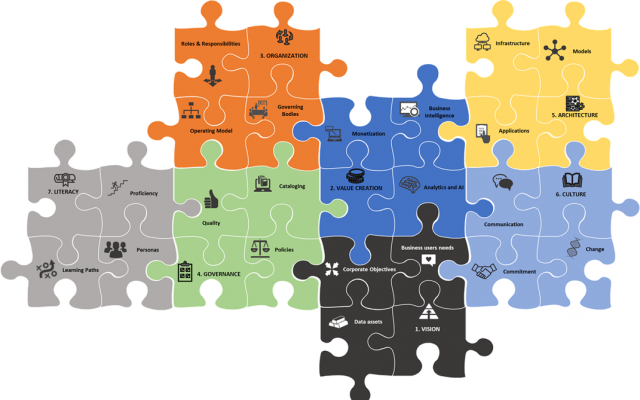Which topics you need to address to design an efficient data strategy and why.
In Episode 1 of the Data Strategy Made Simple series, I explained that a simple one liner statement is enough to define a data strategy, BUT it is only the beginning of the story. All the dimensions of the data strategy need to be addressed specifically and detailed.
So, what are those dimensions? Well, it depends how you understand the scope of Data Strategy. Some companies address Data Strategy as a Business Intelligence topic. Some others focus only on governance aspects. Some believe Data Strategy is about Big Data and having a Data Lake. Some think Data Strategy is about Artificial Intelligence. I could go on with this list and provide many other examples. What this list actually shows is a misconception regarding the real scope of Data Strategy.
As stated in Episode 1, a data strategy will translate into a series of actions, activities, programs, projects and initiatives aimed at setting up a data ecosystem addressing all the challenges of the data strategy. Thus, focusing on only one part of this data ecosystem will limit the reach and value of your data strategy. For instance, focusing a data strategy only on analytical matters will generate risks linked to the sustainability of the insights produced by analytical projects or initiatives if the question of data quality is not addressed properly. Another example: focusing only on data governance will ensure your data assets are well governed and organized but not necessarily that value is created out of those assets.
What we need is to have a clear understanding of what is a data ecosystem to be able to define the dimensions of a data strategy. In my opinion, and in the context of data strategy,
A Data Ecosystem is a set of functional, technological and human elements to manage the data lifecycle and create value based on data assets.
This Data Ecosystem is only a part of all the elements constituting any organization. It interacts with the financial ecosystem, the IT ecosystem, the commercial ecosystem, etc. It’s pretty much like a gigantic puzzle where each piece is part of a specific ecosystem and is linked to all the other parts of the organization.
Looking at the functional, technological and human elements required to manage the data life cycle and create value based on data assets, I suggest focusing on the following dimensions:
- Governance: policies, principles, rules, procedures, standards
- Organization: functions, roles and responsibilities
- Architecture: technological environnement, infrastructure, tools
- Value creation: use cases, exploitation, consumption
These dimensions constitute a solid basis to start building up a data strategy. Companies that have designed data strategies based on these 4 dimensions will be able to create value from their data assets. Whether they will successfully create value from their data assets in the long run is however questionable. Back in 2017, Gartner stated that 85% of big data projects failed. As it is often the case with figures coming from Gartner, the 85% has been since then heavily re-used and extended to data projects at large and not only Big Data projects. The reason why no one has really challenged that figure and the way it us used is because most data practitioners on the market believe it is correct. Based on my experience, data initiatives and projects are indeed difficult to land. I wouldn’t say that 85% of these projects fail. What I would say though is that at least 85% of data projects fail to meet initial expectations.
A major reason for that is linked to the inadequate definition or lack of definition of a comprehensive and holistic data strategy. To be clear, the 4 dimensions above are not sufficient. They need to be completed by:
- Vision: a clear overview of the purpose of data within the company (remember the one liner statement?)
- Culture: the ability of a company to embed and use data in the decision-making process
- Literacy: the analytical, technical and critical thinking skills and knowledge needed by employees at every level of a company
It is these 7 dimensions that need to be addressed to design the right Data Strategy and build a strong Data Ecosystem. Failing to address all of them or focusing only on a selection of these will inevitably create holes in the overall puzzle.
1. VISION
First things first. What is the purpose of Data in your organization? How important is it? How does it connect to the company’s strategic objectives? Are business users’ data needs taken into consideration? These are some of the questions to answer in order to come up with the right vision. Remember, a vision should provide a clear overview of the purpose of data within the company. By the way, this is not cast in stone. It can evolve over time. A vision can be short and/ or long-term.
For more information about VISION, please refer to Data Strategy Made Simple – Episode 1.
The below sections will provide some key features of dimensions 2 to 7. Further details will be provided in upcoming Episodes.
2. VALUE CREATION
How to create value with data? There are many answers to this question. For the sake of simplicity, I will use only 3 categories to start with:
– Business Intelligence: value is created from the ability to transform data into management information.
– Analytics and AI: value is created from the ability to analyze data to produce actionable insights
– Monetization: value is created from the ability to sale data
To fully address this dimension, it will be necessary to focus on the identification and prioritization of use cases, the distinction between the different types of BI (operational, tactical, strategic), the distinction between data analysis and advanced analytics, the demystification of Artificial Intelligence, among other things.
3. ORGANIZATION
Who is in charge of what when it comes to data? Are the roles and responsibilities clearly defined and understood? How many people do we really need? Is our organization fit for purpose? What is the balance of power regarding data matters?
Depending on the objectives set for the data strategy and the data maturity of a company, the choice of the operating model and related roles and responsibilities will significantly impact the ability of the company to deploy efficiently its data strategy. A centralized model might be the most appropriate choice for a company and the most detrimental for another. Whether you opt for a centralized model, a decentralized model, or a hybrid one, the choice needs to be tailored to the specific needs and nature of a given company.
The same is true for the roles and responsibilities. Whether the organization is composed of a Chief Data Officer, a Chief Analytics Officer, data scientists, data analysts, data engineers, data architects, data DevOps, data governance manager, data quality manager, information domain managers, data domain managers, etc… will depend on the specific needs and nature of a given company. I’m a not a big fan of the “Mexican Army” approach with too many roles and too many people. I’m not a big fan either of approaches with too few resources. Unfortunately, both are too often found in companies which haven’t fully grasped the complexities of managing data as an asset. And yes, it is possible to have too many roles. It happens with companies deciding to invest in data without a coordinated approach and a well-defined strategy. Initiatives and projects will pop-up in various parts of the company which might compete with the “official” approach. In these cases, Shadow BI and Shadow Analytics become a reality and create significant confusion on the roles and responsibilities.
There is so much more to say that just these few lines so I will further detail this section in an upcoming article.
4. GOVERNANCE
What are your data assets? Where are they? Who is responsible for these assets? How are they defined? How do they interact? What are the rules governing the management, usage and exploitation of these assets? Can you ensure the quality of your data assets?
There are no doubts that Data Governance is essential to the success of a data strategy. And yet, many companies are either unclear on the objectives of data governance or not investing in it. For many companies, investing in data analytics, Big Data, data science, AI is almost a no-brainer. Even though not all of them have a clear view on the use cases they want to address. But when it comes to Data Governance, there is more debate. The reason for this is that the benefits of Data Governance are not immediately understood. Why should a company invest in activities that create more workload, procedures, rules and policies? Data Governance is not sexy-sorry for my Data Governance colleagues – we know it. But it is essential, and it is high time that all companies working with data understand it. We all know the risks of working with data that is not properly defined, that is of low quality, that is not clean. We all know that a common language in a company is important. We all know that for our analysis to be reliable and sustainable, we need to trust our data.
A very simple example: one company invested several months in a data science project to extract variables from unstructured data sets. Algorithms with high success rates where produced and operations staff were eager to use these findings on a daily basis. When came the time to industrialize, issues with data quality, traceability and accessibility required additional unplanned investments. All of those would have been tackled if a proper data governance framework had been established beforehand.
5. ARCHITECTURE
This dimension is so interesting. Every time I think I have figured it out, something new comes in and changes the game. For clarity’s sake, I’m not a true IT guy. I studied international economics, finance and politics. I entered the IT world in the 2000s as financial responsible for strategic programs of more than 500 million euros. After one year in that position, the CIO offered me to create a team that would analyze IT programs spend. That’s how I entered the world of IT and started learning about it.
All I know about IT, I learned on the field. The same is true for Data Architecture. And what I know now about Data Architecture is that there are different definitions of what it covers. For some, Data Architecture is all about the models, whether conceptual, physical or logical, Data Architecture is viewed as how data originates from source systems, is modeled, is interrelated and feeds applicative systems. For others, Data Architecture focuses on the technological environments enabling the data life cycle. As for me, Data Architecture is about all of this and more. Data Architecture is indeed about models, infrastructure, platforms, data life cycle, applications, tools. And it is also the enabler of data value creation. To be efficient and fit for purpose, a Data Architecture needs to be aligned to business users needs. In the field of data, business and IT must act as true business partners.
I will further explore this topic in an upcoming article, using a business approach and trying my best to avoid technical jargon.
6. CULTURE
First, why do I distinguish Culture from Literacy when many others put them together? Considering Culture as being the ability of a company to embed and use data in the decision-making process, we need to better understand what this ability is. The Cambridge Dictionary defines Ability as being the power or skill needed to do something, or the fact that someone is able to do something. We know that an ability can be learned or can be innate. Also, Data Culture is the combination of different factors involving habits, mindset, company culture, data maturity, employee profiles and nature of business.
So, I would argue that some companies, due to their very nature and profile, already demonstrate a well-developed Data Culture even though their Data Literacy is not optimal, Some companies are able to embed and use data in their decision making process while not being experts in this field and making mistakes. The question in this case is whether Data Literacy is useful for them. In the long-run, yes, but that will not change their Data Culture. For them, the objective should be to maintain and nurture this existing Data Culture. For the other companies struggling with Data Culture, Data Literacy will be key in their enablement process.
7. LITERACY
Does your staff have the right skills when it comes to data? Who should know what? What are the specific skillset required for a given persona? What is the level of proficiency required for a given function?
Data literacy focuses on bringing the right content to the right people with the right skills, ensuring a proper handling of data related matters. Data literacy encompasses the analytical, technical, and critical thinking skills and knowledge needed by employees at every level of your company. (Cf Article Why data literacy is pivotal in untapping your data value potential)
By providing employees the possibility to acquire the right set of skills to manage and exploit data, companies will increase their ability to leverage the full potential of their data assets. Why? Because employees at all levels will be able to understand and address the challenges of data in a knowledgeable way hence limiting the risk of inadequate actions, project failure and missed opportunities.
In summary:
1. A Data Ecosystem is a set of functional, technological and human elements to manage the data lifecycle and create value based on data assets
2. There are 7 dimensions that need to be addressed to design the right Data Strategy and build a strong Data Ecosystem. Failing to address all of them or focusing only on a selection of these will inevitably create holes in the overall puzzle.
3. Dimensions are:
a. Vision: a clear overview of the purpose of data within the company
b. Value creation: use cases, exploitation, consumption
c. Organization: functions, roles and responsibilities
d. Governance: policies, principles, rules, procedures, standards
e. Architecture: technological environnement, infrastructure, tools
f. Culture: the ability of a company to embed and use data in the decision-making process
g. Literacy: the analytical, technical and critical thinking skills and knowledge needed by employees at every level of a company
As I said in Episode 1, a one liner statement is only the beginning of the story. The real difficulty comes from the definition of the other dimensions of your Data Strategy. Failing to address all the dimensions will inevitably create an unbalanced data ecosystem and in turn generate inefficiencies, issues and missed data value potential.
Welcome to the Data Strategy Puzzle …
Article by channel:
Everything you need to know about Digital Transformation
The best articles, news and events direct to your inbox
Read more articles tagged:
















